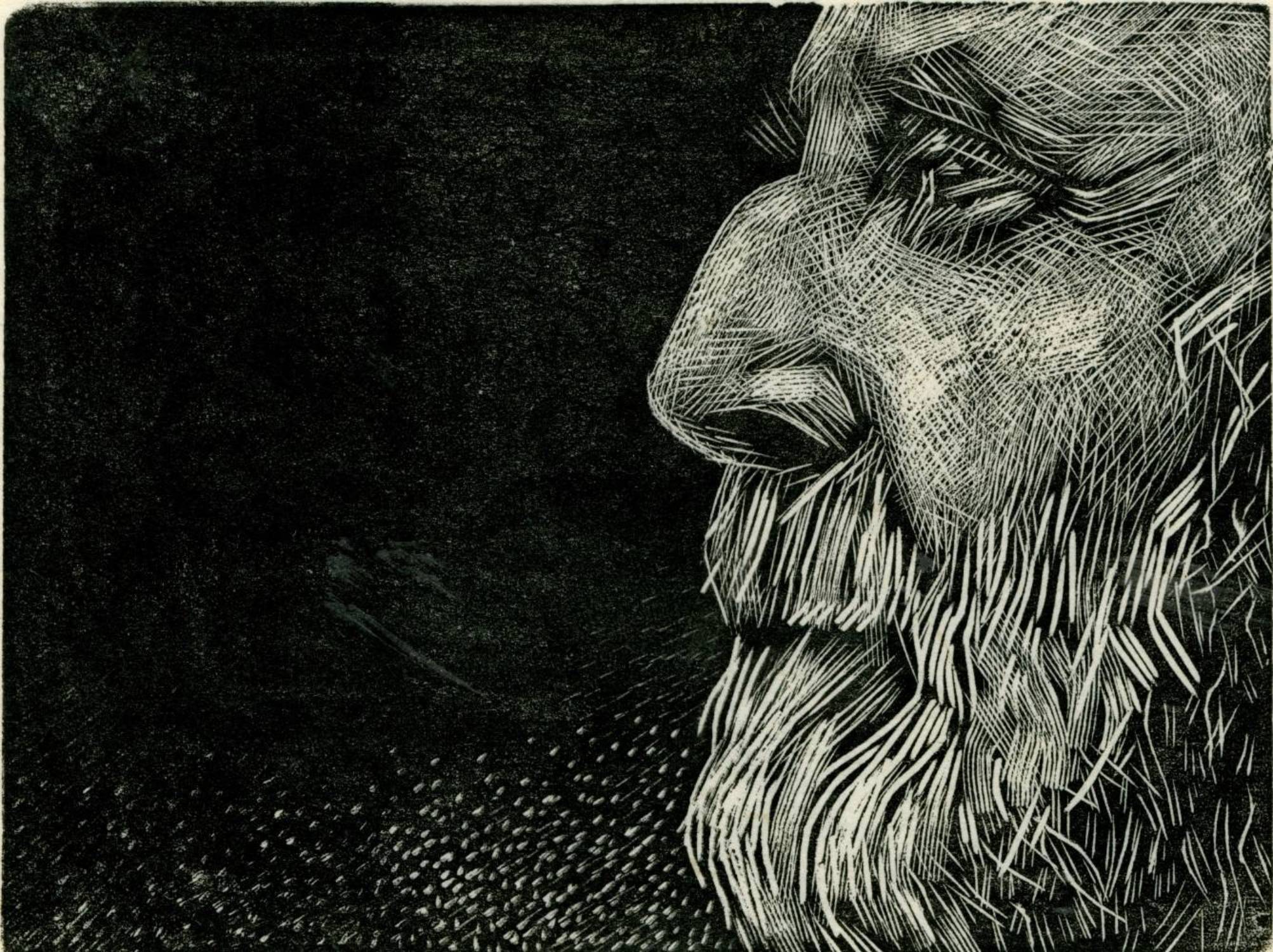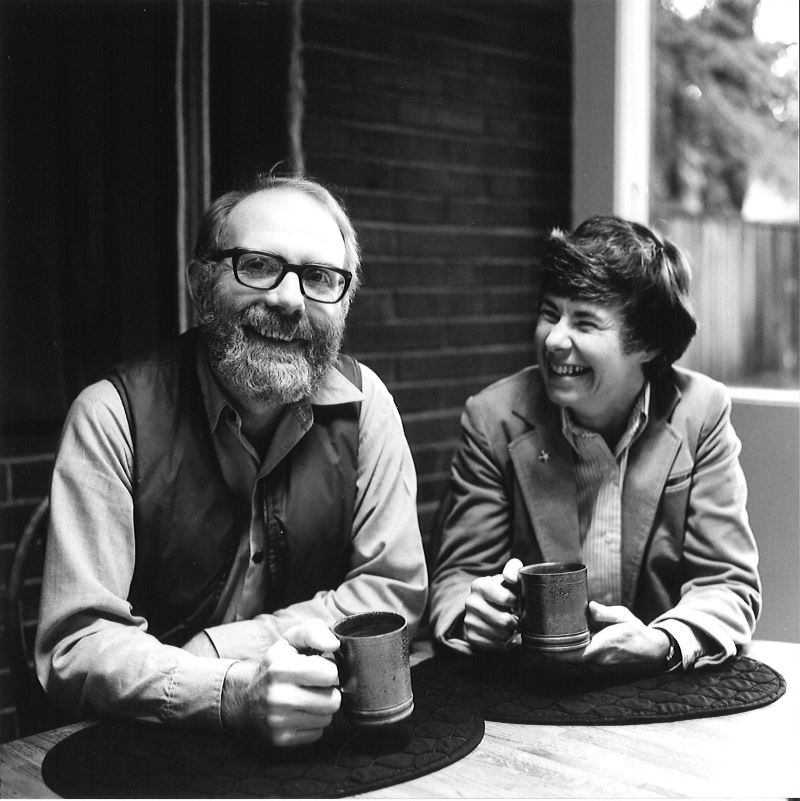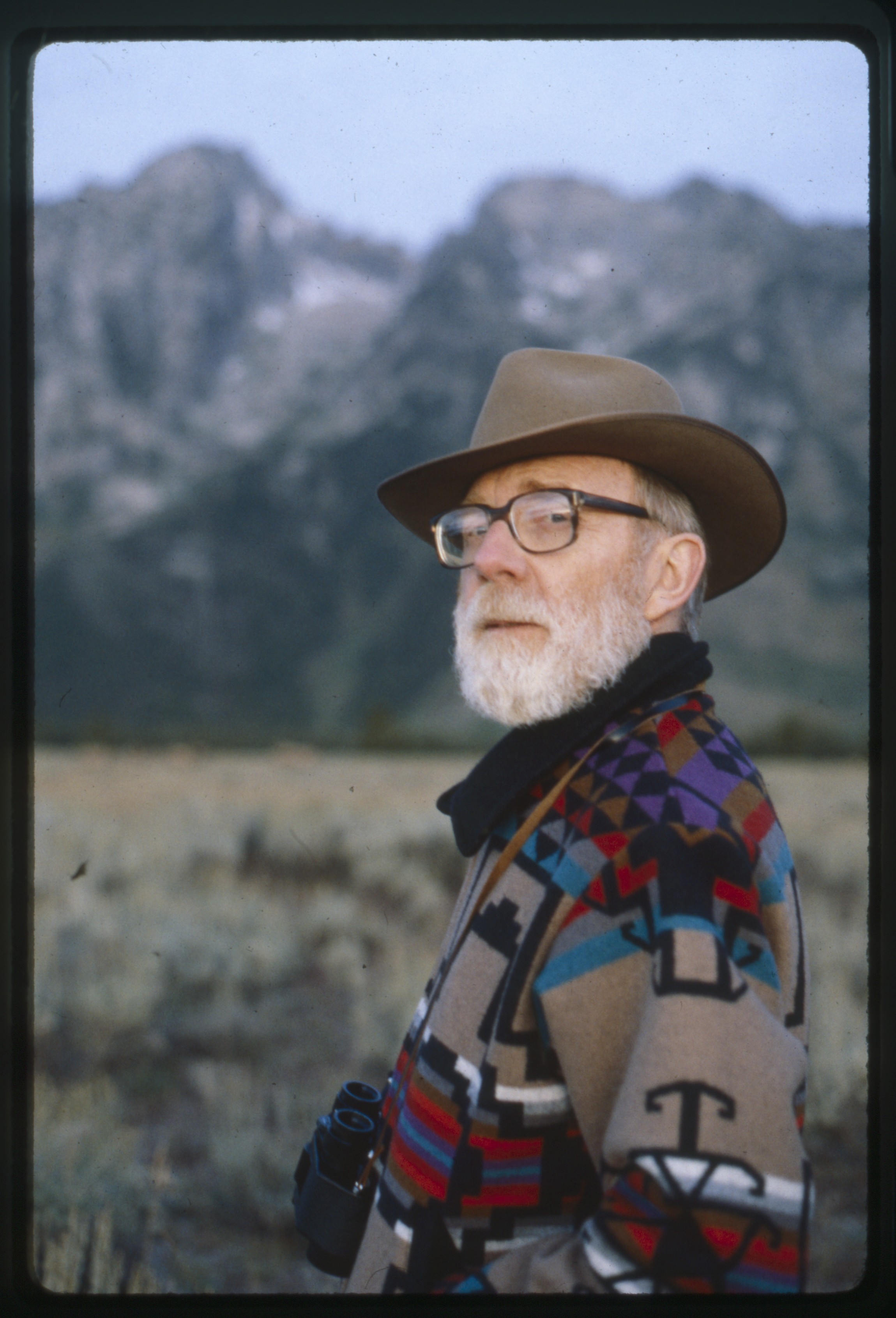About Ivan Doig

credit to James G. Todd
The Ivan Doig Center for the Study of the Lands and Peoples of the North American West at Montana State University fosters and supports interdisciplinary scholarship on the North American West. This mission is inspired by the life of the man for whom the Center is named. In both his professional and personal life Ivan Doig (June 27, 1939 – April 9, 2015) contemplated and explored the West with depth and curiosity. His insightful observations about the region are embodied in his writings, which have helped to influence and shape our collective imagination of the land and people of the West.
Doig was himself shaped by the landscapes of the region, in particular the ranching and farming worlds of rural Montana. Much of his childhood was spent in the agricultural environs of White Sulphur Springs and Ringling, later moving to Dupuyer, along the Rocky Mountain Front. After his mother, Berneta Ringer Doig, died when he was six, Ivan was raised by his father Charlie Doig and grandmother, Bessie Ringer. He would later base most of his best-known writings on the lives and experiences of the ordinary people who called these extraordinary lands their home.
Upon graduating from Valier High School in 1957, he went to study at Northwestern University. Doig spent his time in college exploring a variety of interests. For example, he punctuated his pursuit of journalism by experimentation with poetry. At Northwestern University, he received a bachelor’s and a master’s degree in journalism in 1961 and 1962, and then went on to pursue a PhD in History at University of Washington, graduating in 1969. It was during his time in Illinois that the author met his wife, Carol Muller, who would become his most important collaborator and partner. They married in 1965. In 1966, and Ivan and Carol headed west, settling in Seattle, Washington. [1] Shortly after, the couple published News: A Consumer’s Guide, establishing the strong collaborative relationship that would define Ivan’s writing process.

Not long after receiving his PhD, Doig began working on This House of Sky. The memoir of his Montana childhood and coming of age marked the beginning of a prolific writing career that included almost a dozen major books and numerous short pieces. For many readers and critics, these books solidified his place as an important western writer and thinker. Throughout his career, Doig dedicated himself to writing about and foregrounding ordinary people in the West and the ways western lands challenged, shaped, and inspired their experiences and lives. During his career, Doig compiled thousands of 5x8 file cards recalling the colloquial language of working-class people he remembered from his childhood on a sheep ranch. For Ivan, Western literature was much more than just about place, it was all about the people who lived, worked, toiled, and spoke on the land. [2] Ivan argued that “language is the whole point… the dance of language on the page is what literature is all about.” [3]
Doig’s interests and writing frequently extended beyond literature. Doig used his
training in History throughout his career. Author David Laskin said of Doig’s interdisciplinary
approach: “Ivan brought history to the page through his imagination, through his characters,
but the history, damnit, was all accurate!” [6] Additionally, Doig collaborated with
two historians who were also close friends, Dave and Marcella Walter. In one letter
to them, Doig requested “a quick surface go through [of his book] to see if anything
about the setting or local history doesn’t ring right. I’m consciously going farther
than I’ve usually done in stretching or amending history in this novel because the
story seemed to need it.” [9] This dedication to making the historical situations
in his novels “ring right” is just one way that Doig helped ground his writings in
the history of the West.Despite the fact that he set his work in the West, Ivan rejected
the notion of being a regionalist. He saw his work as revealing the conditions of
humanity. Doig loathed what he called, the romantic “cowboy myth” West, because “it
fudges the terms of life in much of the actual American West—that is a big, complicated,
fragile, contentious part of the country.” [4] Ivan argued that in the mythologized West, “None of the guys, good or bad, seems ever
to do a lick of everyday work—milk a cow, churn butter, plant a potato.” [5] A “cowboy-and-Indian
West” was a soulless one that reflected a false reality. For Ivan Doig, the universal
condition and story of the American West was found in the labor of real women and
men.

The personal, the historical, and the literary all blended in Doig’s methodology. Doig claimed that for him “to tap the essences of the West—a big canvas with hard lives being lived against it—[he] never had to look very far to find it.” He simply called on his family, childhood, and past experience. [7] Ivan incorporated moments in his life and places of his past into his fiction and nonfiction. About his own experiences in the West, he once stated, "I come from the lariat proletariat, the working-class point of view.”[10] Yet, he always believed that writers “of real caliber” go beyond the micro and local and convey the larger meaning and significance of what it means to be “American.” [8]
Doig informally inherited from Wallace Stegner the title of “dean of Western Writers.” [11] Like Stegner, Doig supported younger writers. His correspondence with aspiring authors from around the county foregrounds his willingness to support their work, albeit with a healthy dose of constructive criticism. Doig did not see a reason to sugar coat anything, and his straightforward approach to writing contained guidance that he himself would want. When explaining his reasons for offering some particularly blunt advice, the author confessed, “I know these comments will smart, and I much regret that. But I’m about to send out the first chapters of my next novel to a friend to read, and as I told her in urging her to be tough on the work, ‘what I need at this point is a hard scrimmage, not cheerleading.’”[12] Often, the writers who reached out to Doig for advice on their work did so because of his straightforward vision. Describing the deep connection to place that Doig conveyed in his novels, for instance, one author explained that he wrote to him for advice because the “closeness you have with Montana is what I feel for my state, Nebraska.”[13]
After a long writing career, Doig died of multiple myeloma in April 2015 at age 76. In a note he left, the author wrote: “If I have any creed that I wish you as readers, necessary accomplices in this flirtatious ceremony of writing and reading, will take with you from my pages, it'd be this belief of mine that writers of caliber can ground their work in specific land and lingo and yet be writing of that larger country: life.” [14]
[1] Our thanks to the Ivan Doig Archive for allowing us to draw on their biography of the author. Visit the archive here. See also Doig’s professional website.
[2] Jean Walkinshaw, interview with Ivan Doig. Westwords: Six Western Writers. KCTS Seattle, 1995.
[3] Walkinshaw interview.
[4] Ivan Doig, speech given at Missoula, circa 1971, 2602-B114-F17-001-319, Ivan Doig Archive, Montana State University Special Collections, Bozeman, Montana
[5] Doig speech.
[6] Walkinshaw interview.
[7] Walkinshaw interview.
[8] Walkinshaw interview.
[9] Dave (& Marcella) Walter, http://arc,lib.montana.edu/ivan-doig/item/5789, Ivan Doig Archive, Montana State University (MSU) Library, Bozeman, MT.
[10] Sam Roberts (April 10, 2015). "Ivan Doig, Author Who Lived the Western Life, Dies at 75". The New York Times.
[11] See www.ivandoig.com/memoriam.html
[12] See www.ivandoig.com/memoriam.html
[13] Ivan’s responses to letters about writing, http://arc,lib.montana.edu/ivan-doig/item/5544, Ivan Doig Archive, Montana State University (MSU) Library, Bozeman, MT.
[14] See www.ivandoig.com/notes.html.
Writings by Ivan Doig
This list was compiled by the Ivan Doig Archive.
- Doig, I. (1969). The Genial White House Host and Ranconteur. Journal of the Illinois State Historical Society, 62, 307-11.
- Doig, I. (1970). Washington’s First Smoke Jumper. Seattle Times, Sunday, July 5,12-13.
- Doig, I. and Doig, C. (1972). News: A Consumer's Guide. New Jersey: Prentice Hall.
- Doig, I. (1975). The Streets we Have Come Down. Textbook. New Jersey: Hayden.
- Doig, I. (1976). Utopian America: Dreams and Realities. New Jersey: Hayden.
- Doig, I. (1976). Early Forestry Research: A History of the Pacific Northwest Forest & Range Experiment Station, 1925-1975. Washington DC: U.S. Forest Service.
- Silen, R.R., and Doig, I. (1976). The care and handling of the forest gene pool. Pacific Search, 10(4), 7-9.
- Doig, I. (1978). End of the Hunt. Seattle Times Magazine, Sunday, September 17.
- Doig, I. (1978). This House of Sky: Landscapes of a Western Mind. New York: Harcourt & Brace Co.
- Doig, I. (1980). Winter Brothers: A Season at the Edge of America. Harcourt & Brace Co.
- Doig, I. (1982). The Sea Runners. New York: Atheneum.
- Doig, I. and Kelso, D. (1983). Inside This House of Sky. New York: Atheneum.
- Doig, I. (1984). English Creek. New York: Atheneum.
- Doig, I. (1985). The Heaneys. Northwest Magazine, Jan 6, 10-11.
- Doig, I. (1985). You Can't Not Go Home Again. Montana The Magazine of Western History, 35 (1), 2-15.
- Doig, I. (1987). Dancing at the Rascal Fair. New York: Atheneum.
- Doig, I. (1988). Sophisticated Traveler: At Home with Lassie and her Ilk. New York Times Magazine, part 2, 13.
- Doig, I. (1990). Ride with Me, Mariah Montana. New York: Atheneum.
- Doig, I. (1993). A River Runs through It: A Review. Montana The Magazine of Western History, 43 (1), 70-73.
- Doig, I. (1993). Heart Earth: A Memoir. New York: Atheneum.
- Doig, I. (1993). Thoughts on Wallace Stegner. Montana The Magazine of Western History, 43 (4), 70-71.
- Doig, I. (1996). Bucking the Sun. New York: Simon & Schuster.
- Doig, I. (1999). Mountain Time. New York: Scribner.
- Doig, I. (2003). Prairie Nocturne. New York: Scribner.
- Doig, I. (2003). Edgewise in Nature. Building Tradition: Gifts in Honor of the Northwest Art Collection.
- Doig, I., Hampton, H., Murphy, M., Malone, M., Margaret Kingsland, Dorothea M. Susag, & Swartout, R. (2006). Remembering Dave Walter. Montana The Magazine of Western History, 56 (3), 66-71.
- Doig, I. (2006). The Whistling Season. New York: Harcourt Brace and Company.
-
Doig, I. (2008). The Eleventh Man. Montana The Magazine of Western History, 58(2), 22-40.
- Doig, I. (2008). The Eleventh Man. New York: Harcourt Brace and Company.
- Doig, I. (2010). Work Song. Riverhead Publishing.
- Doig, I. (2011). The Bob and I, Under the Big Sky, Wilderness Society 2011-2012. Wilderness, 28-29.
- Doig, I. (2012). The Bartender's Tale. Penguin Publishing Group.
- Doig, I. (2013). Sweet Thunder. Riverhead Publishing.
- Doig, I. (2015). Last Bus to Wisdom. Riverhead Publishing.
Writings about Ivan Doig
This list was compiled by the Ivan Doig Archive and has been updated by the Ivan Doig Center to include new publications.
- Staebler, G. (1976). Review. Journal of Forest History, 20 (4), 215.
- Malone, M.P., (1979). Review. The Pacific Northwest Quarterly, 70 (4), 180.
- Ahearn, K.D. (1983). Ivan Doig's Self-Narratives: The West, Wilderness, and the Prophetic Impulse. South Dakota Review, 20 (4), 7-22.
- Bingham, E. (1987). American Wests through Autobiography and Memoir. Pacific Historical Review, 56 (1), 1-24.
- Robbins, W. (1987). The Historian as Literary Craftsman: The West of Ivan Doig. The Pacific Northwest Quarterly, 78 (4), 134-140.
- Zirinsky, D. and Morache, J. (1989). Reclaiming the Canon: Ivan Doig: Northwestern Writer for Secondary Students, The English Journal, 78 (5), 74-77.
-
Simpson, E. (1992). Earthlight, Wordfire: The Work of Ivan Doig.
- Meldrum, B.H. (1993). Creative Cowgirl: Mary Clearman Blew's Herstory. South Dakota Review, 31, Spring, 63-72.
- Larson, J. (1994). Ivan Doig's Montana. The English Journal, 83 (7), 106-107.
- Egan, K. (2000). Montana Apocalypse: Extremism and Hope in the American West. Western Futures: Perspectives on the humanities at the millenium, 17-30
- Huber, W. (2000). Fortunate Lives: A.B. Facey and Ivan Doig, Memoirists of the Frontier. Heritage of the Great Plains, 33 (1), 5-16.
- Karell, L. (2002). Collaboration and Contradiction in the Western Memoir: Ivan Doig, Mary Clearman Blew, and William Kittredge. Writing Together, Writing Apart.
- Sheffeld, D. (2006). Conversation with Middle-Class Cosmic Mechanic, Ivan Doig. Page to page : retrospectives of writers from the Seattle review, 229-252.
- Wyckoff, W. (2012). Ivan Doig's Montana and the creation of place-defining literature. Journal of Cultural Geography, 30 (1), 90-119.
- Wyckoff, W. (2018). “Every Word Belongs.” Montana: The Magazine of Western History [Special Issue on Ivan Doig] 68 (2), 3-5.
-
Kollin, S. (2018). “The Ivan Doig Symposium at Montana State University.” Montana: The Magazine of Western History [Special Issue on Ivan Doig] 68 (2), 6.
-
Rasker, J. and J. Zauha. “Ivan Clark Doig and His Literary Works, 1939-2015.” Montana: The Magazine of Western History [Special Issue on Ivan Doig] 68 (2), 7-11.
-
Fockler, M. “Creating ‘An In-Between Thing’: The United States Forest Service and Ivan Doig’s Two Medicine Country.” Montana: The Magazine of Western History [Special Issue on Ivan Doig] 68 (2), 12-31.
-
Cook, N. “Writer as Labor Historian: The Changing World of Work in Ivan Doig’s Montana Books.” Montana: The Magazine of Western History [Special Issue on Ivan Doig] 68 (2), 32-47.
-
Mackin, J. (Ramaker). “Home Ground and Kin: Ivan Doig’s Montana.” Montana: The Magazine of Western History [Special Issue on Ivan Doig] 68 (2), 48-58.
-
Ferguson, L. “Born to Be Published: Ivan Doig and Taylor Gordon.” Montana: The Magazine of Western History [Special Issue on Ivan Doig] 68 (2), 59-65.
-
Murphy, M. “On Writing and Writers: A Conversation between Carol Doig and Lois Welch.” Montana: The Magazine of Western History [Special Issue on Ivan Doig] 68 (2), 66-72.
-
Saletan, R. “Savvying the Rhythms: Editing Ivan.” Montana: The Magazine of Western History [Special Issue on Ivan Doig] 68 (2), 73-76.
-
McKelvey, H., J. Zauha, and J. Clark. “The Ivan Doig Archive at Montana State University.” Montana: The Magazine of Western History [Special Issue on Ivan Doig] 68 (2), 77-78.
